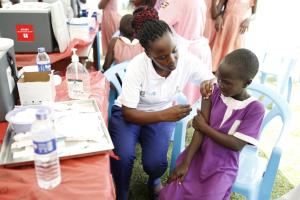Uganda achieves 92% coverage in accelerated yellow fever vaccination campaign
Kampala-Under the aegis of the Global Eliminate Yellow Fever Epidemics (EYE) strategy and with support from Gavi, UNICEF, WHO, and Uganda’s Ministry of Health, the country has successfully completed phase 3a of its nationwide accelerated yellow fever vaccination campaign in response to the epidemiological situation, achieving an impressive 92% vaccination coverage in the 19 targeted districts. This phase, undertaken on 10-16 April 2025, was particularly significant as it was also used to respond to an active outbreak. A total of 4,223,862 Ugandans, aged between 9 months and 60 years, were vaccinated out of a target population of 4,635,913, marking an important milestone in the country's fight against the disease.
Yellow fever is a severe viral disease transmitted by mosquitoes. It causes symptoms such as yellowing of the skin and eyes (jaundice), dark urine, abdominal pain, vomiting, and bleeding from the mouth, nose, eyes, or stomach. The disease is preventable through vaccination. To ensure adequate coverage, field teams were deployed to administer vaccines to the eligible populations.
Since the introduction of the yellow fever vaccine into Uganda’s routine immunization (RI) programme in October 2022, the country has demonstrated a strong commitment to eliminating yellow fever epidemics nationwide, in line with the EYE Strategy. This initiative aims to reduce the risk of virus transmission by protecting people living in endemic areas, as well as travellers who may carry the disease to new regions. For this reason, yellow fever vaccination is mandatory for anyone travelling to high-risk areas.
The campaigns conducted so far (from Phase 1 through Phase 2), including phase 3a have successfully covered 123 out of Uganda’s 146 districts, protecting over 25.8 million people from yellow fever. In Phase 3a specifically, the highest-performing districts were Kibuku (the epicentre of the outbreak), Mbale, and Bududa, which achieved administrative coverage rates of 117%, 113%, and 105% respectively, surpassing their targets. Only one district, Butebo, fell below the 80% coverage threshold. The coverage rates were 93%, 90%, and 86% in Bugisu, Bukedi, and Busoga, respectively. The Post-coverage survey will be underway over the next couple of weeks.
The strong performance was partly due to robust monitoring systems, effective collaboration with the Ministry of Education, including real-time dashboards and adequate national supervision, which enabled targeted interventions and efficient campaign management. Early engagement of local governments, schools, and religious leaders also played a key role in addressing vaccine hesitancy. Additionally, partners demonstrated operational excellence through timely vaccine delivery, availability of buffer stocks, and the deployment of dedicated data entry teams, all of which contributed to the smooth execution of the campaign.
The Ministry of Health extends its gratitude to all partners, health workers, and community leaders who contributed to the campaign’s success. This achievement brings Uganda closer to eliminating yellow fever epidemics.
